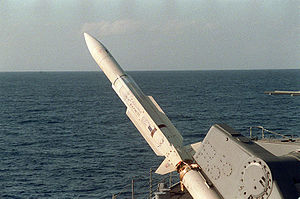The Aegis Combat System is an integrated naval weapons system developed by the Missile and Surface Radar Division of RCA, and now produced by Lockheed Martin. It uses powerful computers and radars to track and guide weapons to destroy enemy targets. It is used to protect ships from attack. Over 100 Aegis-equipped ships have been deployed in five navies worldwide.
The Aegis Ballistic Missile Defense System (Aegis BMD) is a United States Department of Defense Missile Defense Agency program developed to provide defense against ballistic missiles. It is part of the United States national missile defense strategy. Aegis BMD (also known as Sea-Based Midcourse) is designed to intercept ballistic missiles post-boost phase and prior to reentry.
It enables warships to shoot down enemy ballistic missiles, by expanding the Aegis Weapon System with the addition of the AN/SPY-1 radar and Standard missile technologies. Aegis BMD-equipped vessels can transmit their target detection information to the Ground-Based Midcourse Defense system and, if needed, engage potential threats using either the SM-2 or SM-3 missile. The current system uses the Lockheed-Martin Aegis Weapon System and the Raytheon RIM-161 Standard Missile 3 (SM-3).
A new generation of Standard extended range missiles is expected to become operational in 2011. The RIM-174 Standard Extended Range Active Missile (ERAM), or Standard Missile 6 (SM-6) is a missile that has just gone into production for the United States Navy and the Royal Australian Navy. The missile uses the air frame of the earlier SM-2ER Block IV (RIM-156A) missile, adding the active radar homing seeker from the AIM-120C AMRAAM in place of the semi-active seeker of the previous design. This will improve the capability of the Standard missile against highly agile targets, and targets beyond the effective range of the launching vessels’ target illumination radars.
In 2009, the Obama Administration killed plans to build a European version of the ground-based missile defense system already deployed in California and Alaska because of political controversy — including threats against host nations from Russia. It opted instead to use Aegis technology for a defense of European and other regional allies against the ballistic missiles Iran is fielding. The USS Monterey’s foray into the Mediterranean Sea is the first Navy mission implementing the revised plan, one that will be followed by a continuous sea-based missile defense capability in the region and a shore-based deployment of Aegis technology in Romania beginning in 2015. The White House plan, referred to as the Phased Adaptive Approach, calls for protecting an increasingly broad swath of Europe in four successive stages through 2020 as Aegis missiles, computers and radars become more capable.
A key feature of the current plan is to net together Aegis with other overhead and surface-based systems so that the overall architecture not only affords multiple layers of protection, but also maximizes the utility of each element. For instance, once all the sensors are inter-netted, a Standard Missile on the USS Monterey will be able to engage attackers beyond the targeting range of the warship’s radar.
A land-based component is Aegis Ashore. This would consist of equipment which is commonly used by the Navy being deployed in land-based facilities. This would include SPY-1 radars and a battery of Standard Missile-3s. The Obama administration’s plans call for two sites: the first in Romania in 2015 and the second in Poland in 2018. In 2020, both will get the latest versions of the Aegis BMD software and the latest version of the SM-3.
The Multi-Mission Signal Processor (MMSP) will be installed in US Navy ships starting in 2012. This will result in the merger with Aegis Ballistic Missile Defense System.
If you liked this article, please give it a quick review on ycombinator or StumbleUpon. Thanks

Brian Wang is a Futurist Thought Leader and a popular Science blogger with 1 million readers per month. His blog Nextbigfuture.com is ranked #1 Science News Blog. It covers many disruptive technology and trends including Space, Robotics, Artificial Intelligence, Medicine, Anti-aging Biotechnology, and Nanotechnology.
Known for identifying cutting edge technologies, he is currently a Co-Founder of a startup and fundraiser for high potential early-stage companies. He is the Head of Research for Allocations for deep technology investments and an Angel Investor at Space Angels.
A frequent speaker at corporations, he has been a TEDx speaker, a Singularity University speaker and guest at numerous interviews for radio and podcasts. He is open to public speaking and advising engagements.

